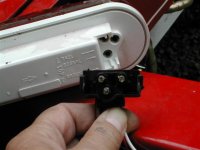Series resistors are an unnecessary addition, if you do the schematic like I have on my web page.
The voltage regulator, operating as a current regulator, handles all the necessary current limiting for all the strings.
With this design, you're cutting down your parts count quite a bit, and risking burning out LED's by about 0.5%. Certainly nothing to worry about.
I have that exact design in my truck's taillights and it works fine. Beats replacing bulbs every 6 months. See, my oversized alternator likes to "drift".
Due to ohms lawn, current resistors in series with LED's require the voltage to be known. Alternators *should* be 13.5V all the time, however we know a lot of factors influence that value. Turn on the AC and the lights, have a weak battery, moisture in the regulator, poor battery connections, etc, can easily cause the voltage to fluctuate slightly. The biggest factor in voltage is RPM. How often do we run our vehicles at a constant RPM? Never! We brake, accelerate, etc.
Minor fluctuations in voltage yes, but they are there non the less.
If you really, really want to run each LED in parallel, using one current liminting resistor per LED, calculate things using 14V just to be safe. That gives you 1.5K resistors, I think, instead of 1K or 1.2K.




